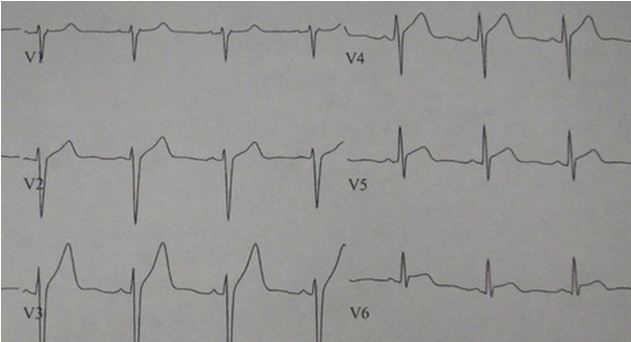- Clinical Technology
- Adult Immunization
- Hepatology
- Pediatric Immunization
- Screening
- Psychiatry
- Allergy
- Women's Health
- Cardiology
- Pediatrics
- Dermatology
- Endocrinology
- Pain Management
- Gastroenterology
- Infectious Disease
- Obesity Medicine
- Rheumatology
- Nephrology
- Neurology
- Pulmonology
Myocarditis Incognito
Figure. ECG, precordial leads.

A 31-year-old man presents to the emergency department with sore throat, body aches, dry cough, chest pain, and fever of several days’ duration. He is otherwise healthy and denies use of tobacco or illicit drugs. The chest pain is significantly worse than the body aches and concerns him most. He states he never has had this kind of pain associated with respiratory infections in the past. The patient describes the pain as a constant “ache” in the middle of his chest that is neither pleuritic nor exertional, but is persistent and not worsened by, or apparently related to, coughing.
On physical examination, his vital signs are normal except for a temperature of 38.4°C (101.2°F) and a pulse of 108 beats/min. His head and neck exam is normal except for rhinorrhea. There is no apparent pharyngitis or lymphadenopathy. His lungs have no rales but some mild expiratory wheezing is noted. Heart sounds are normal except for the elevated rate. His abdomen is benign. Extremities have symmetric pulses with no edema, tenderness, or chords. The patient is given acetaminophen and oral fluids, and his vital signs normalize. An influenza swab is sent for testing and results are negative. A chest x-ray film is read by the radiologist as normal. An ECG is also obtained. The precordial leads are shown in the Figure above (click on image to enlarge).
Is this ECG normal or abnormal? What is the most likely diagnosis?
Answers: Abnormal; see below for diagnosis.
The peaked T waves and slight ST elevation in V3-V4, though eye catching, are likely only benign early repolarization, which is a normal variant. However, there is mild ST elevation in the lateral leads (V5 and V6), which appear pathologic. Serial ECGs showed no change. Cardiology was consulted and felt this was not an acute coronary syndrome. The troponin did come back elevated at 12.2 µg/L.
Chest pain in the setting of a viral syndrome has many potential causes, but when the pain is constant, non-pleuritic, and not related to coughing and the ECG shows ischemic changes, myocarditis needs to be strongly considered, especially in the absence of cardiac risk factors.
Myocarditis typically presents with fever and chest pain that may be exertional. Dyspnea and leg swelling may also occur as may a variety of nonspecific viral symptoms. Physical examination may be normal early on or in mild cases, but more severe cases may manifest abnormal vital signs and signs of congestive heart failure, such as jugular venous distention, pulmonary rales, and/or peripheral edema.
The ECG may show nonspecific or ischemic ST-segment and T-wave changes as well as heart block or dysrhythmia in more severe cases. Troponin elevation occurs in about one-third of cases, but is more likely when newer ultrasensitive troponin assays are used. Echocardiogram many show decreased ejection fraction, usually with global hypokinesis rather than the focal wall motion abnormalities typically seen in coronary disease.
Myocarditis is usually viral in nature and there is no specific therapy other than supportive care for complications; however, targeted antimicrobials or corticosteroids may be used in cases in which a treatable etiology is suspected. See Table below for causes to consider. Heparin may be used to prevent deep venous thrombosis.
Cardiology was consulted on this case and agreed with the ED physician that this was not myocardial ischemia and urgent angiogram was not indicated. The patient was hospitalized and eventually viral myocarditis was diagnosed. The troponin peaked at 29 µg/L. The ejection fraction dropped to 40%, but fortunately returned to normal 2 weeks after discharge.
Table.
